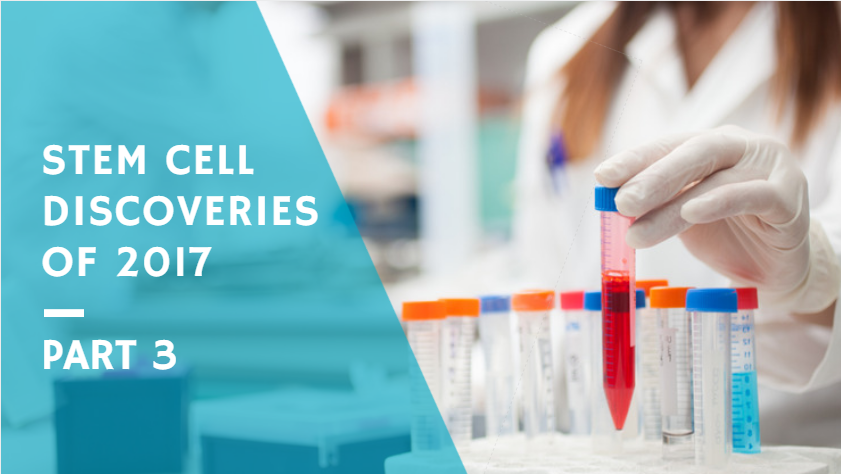
Welcome to part three of our series on the best stem cell discoveries in 2017. This series highlights some of the most exciting stem cell discoveries and the potential implications they may have for medical science.
Stem Cell Therapy Offers Hope for Multiple Sclerosis Remission
Multiple Sclerosis is an autoimmune disease that makes the immune system destroy the protective lining coating neurones found in the brain and nervous system. Once the protective coating is damaged or destroyed, the nerve cells no longer function correctly, causing tremors, speech problems, pain, and various other symptoms.
A British company named LIFNano Therapeutics has developed a new stem cell therapy that may cure MS. The therapy uses a naturally occurring stem cell protein to produce more myelin in the body — the substance that protects the nerve cells. If clinical trials are successful, this therapy may be used to cure MS or dramatically reduce its symptoms. Read more about this research
Stem Cell Therapy Potentially Effective in Crohn’s Disease
Crohn’s disease is an inflammatory bowel condition. It causes a wide range of symptoms including bloating, fatigue, diarrhoea, nausea, abdominal pain, and weight loss. It is a serious disease that can sometimes have life-threatening complications.
Researchers have been testing the effect of stem cell transfusions on Crohn’s disease for a number of years. A group of researchers recently gathered the results of all of these studies and discovered that from the 514 patients who had received a stem cell transfusion, 56% saw an improvement in their condition. Researchers suggest that these positive findings mean stem cells may eventually be used to find a treatment for the condition. Read more about this research
Autologous Cord Blood Infusions Determined Safe for Children with ASD
One of the most exciting potential uses for stem cells is to treat autism spectrum disorder (ASD). Earlier this year, a group of scientists from Duke University’s Robertson Clinical and Translational Cell Therapy Program tested the efficacy and safety of autologous stem cells for treating ASD.
The researchers discovered that using a child’s own stem cells to treat their ASD is perfectly safe. They also discovered that stem cells are already proven to be effective for treating ASD. Most children who receive a transplant see an improvement in their ASD symptoms. Read more about this research
New Stem Cell Therapy Holds Promise as a Treatment for Chronic Asthma
Australian researchers from the Monash Biomedicine Discovery Institute (BDI) have developed a stem cell therapy that can be used to treat chronic asthma. If clinical trials are successful, it could help millions of people worldwide.
The treatment begins by taking some skin cells from a patient and changing them into induced pluripotent stem cells (iPSCs). Those cells are then changed into mesenchymal stem cells (MSCs). The MSCs have the ability to reduce inflammation and regenerate damaged lung tissue. Because they are generated from the patient’s own cells, there is no risk of rejection. Read more about this research
Recent Clinical Research in Using Stem Cells for Type 1 Diabetes
Researchers have already discovered that stem cells are very effective at treating autoimmune conditions. In 2017, the research community made some very important steps towards using stem cells to treat Diabetes Type 1, a chronic inflammatory condition affecting millions of people.
Diabetes type 1 occurs when a person’s immune system mistakenly attacks their pancreatic beta cells, which are responsible for producing insulin. Without sufficient levels of insulin in the body, glucose in the blood cannot enter cells and blood glucose levels can become very high.
A study published earlier this years suggests that autologous hematopoietic stems cells (AHSC) can be used to reset the immune system and prevent it from attacking pancreatic beta cells. This could potentially cure diabetes type 1. Read more about this research
Enhanced Cord-Blood-Derived Immune Cells Strike B-Cell Cancers
Researchers in the United States published a paper that explains how cord blood-derived immune cells can target B-Cell cancers. The findings could help researchers develop much more effective cancer treatments. Read more about this research
Using Stem Cells to Grow Functional, Bioengineered Arteries
Some of the most exciting research projects in 2017 have involved the use of stem cells to engineer new organs. One research project used stem cells to grow functional arteries. The arteries could be used to help people who are suffering from heart disease or a genetic disorder that affects their cardiovascular system. Read more about this research
Nano-in-Micro Stem Cell Therapy Could Rescue Blood Flow After Injury
When a person’s blood flow is interrupted, their cells begin to die. The term ischaemia is used to describe this process.
Researchers from China have developed a new stem cell therapy to help restore blood after an injury has occurred, preventing ischaemia. The therapy prompts stem cells into creating new blood vessels to get blood to the site of an injury. This treatment could help millions of people each year. Read more about this research
Scientists Create 3D-Printed Brain-Like Tissue Using Stem Cells
Australian researchers have come up with one of the most exciting stem cell breakthroughs of 2017. They used a 3D printer and bio-ink containing stem cells to print replacement brain tissue.
The process starts by obtaining induced pluripotent stem cells (iPSCs) from a patient’s skin cells. The cells are then prompted into becoming neurones (brain cells) and added to a special bio-ink. The bio-ink is placed into a 3D printer, which can then produce brain-like tissue. If scientists can perfect the technique, it may be used to help people with chronic neurodegenerative conditions like Parkinson’s disease and Alzheimer’s disease. Read more about this research
Thanks for reading A Recap of the Best Stem Cell Discoveries of 2017: Part 3. You can continue reading about the many amazing stem cell discoveries in 2017 in part 4 of our series.
{{cta(‘d59882b5-74e2-4033-be94-d4c340e1978c’)}}


